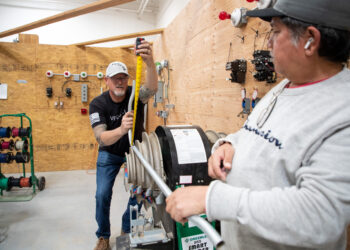
Culinary careers are sizzling again as the hospitality and restaurant industry bounces back from the pandemic and seeks to fill the positions vacated during the COVID-19 downturn. Chaffey College is doing its part to get more cooks in the kitchen.

This is what the skills gap looks like:
One third of businesses around the country have an unfilled job opening because they cannot find qualified help. In South Dakota, one firm in dire need of welders recently offered applicants a $1,000 bonus to apply for a training program. And a Harvard Business School report found that nearly 70 percent of human resource executives who were surveyed said their inability to attract and retain middle-skills talent often gets in the way of their company’s performance.
“There are not enough people to fill these jobs,” said Jon Caffery, director a regional grant through the Trade Adjustment Assistance for Community Colleges and Career Training who is based at College of the Desert. “There are not anywhere near enough people with the skills that are needed.”
That’s why career education programs at the 12 community colleges in San Bernardino and Riverside counties are so vital. And they often make far more sense than heading straight to a university.
“There is a striking anomaly that is happening today: four-year college graduation rates are higher than they’ve ever been, but there are literally millions of unfilled, good-paying jobs,” said Kevin Fleming, dean of instruction for career and education programs at Norco College. “We should no longer ask high school students, ‘What university do you want to attend,’ or ‘what will be your major?’ Instead, we should help a young person by asking, ‘what career do you want to enter into?’ Followed by, ‘what skills do you need to acquire?’”
Anthony Carranza knows. The Navy veteran is entering a career as a certified dental hygienist – a profession that pays an average wage exceeding $90,000 annually in the Inland Empire – thanks to the skills he learned and the training he received at Moreno Valley College. Mitchell Powless knows. He’s a purchasing agent and logistics coordinator for Brenner-Fielder & Associates in Riverside thanks to the skills he learned and the training he received at Norco College. Gari Hewitt knows. She’s embarking on a new career as a nurse thanks the skills she learned and the training she received at Mt. San Jacinto College.
Fleming points out that 27 percent of skilled professionals with a community college certificate or industry certification earn more than the average bachelor’s degree holder. And 33 percent of university graduates are toiling in jobs that do not require a degree.
“The ultimate end is finding a fulfilling, rewarding career where you can provide for your family, feel good about your work and help your community,” Fleming said. “And thousands of students are doing that every year through our community colleges.”
In fact, the number of students earning credentials or an associate degree in a career education field increased more than 70 percent from 2002 to 2012, according to the U.S. Department of Education’s National Assessment of Career and Technical Education.
The need is profound. The top five industries in California that provide good jobs – which have median annual earnings of $55,000 or more – to employees without a bachelor’s degree is led by manufacturing, with 419,000 positions, followed closely behind by health services; information, financial activities and real estate; construction; and retail trade, according to a Georgetown University report. More than half of workers with good jobs in the information, financial activities and real estate sector have good jobs without a bachelor’s degree who have what are considered good jobs with median annual earnings of more than $60,000 annually.
A 2015 Brookings Institution report found that half of all STEM jobs are available to workers without a four-year college degree, and those jobs pay an average wage of $53,000 annually. “These workers today are less likely to be directly involved in invention, but they are critical to the implementation of new ideas, and advise researchers on feasibility of design options, cost estimates, and other practical aspects of technological development,” states the report. “Skilled technicians produce, install, and repair the products and production machines patented by professional researchers, allowing firms to reach their markets, reduce product defects, create process innovations, and enhance productivity. These technicians also develop and maintain the nation’s energy supply, electrical grid, and infrastructure. Conventional wisdom holds that high-skilled, blue-collar jobs are rapidly disappearing from the American economy as a result of either displacement by machines or foreign competition. But the reality is more complex.”
And you can’t argue with success. Students at Riverside City College’s Digital Media program saw a 98 percent increase in earnings after completing their studies, according to the California Community Colleges Chancellor’s Office. Virtually every student completing the Business Program at Norco College is now working in the field, and 88 percent of those students saw their earnings go up. And at Chaffey College, every student who took part in the Electrical Systems and Mechanical Drafting programs are earning the regional living wage.
Community colleges attribute their success to their close working relationship with business and industry in developing and carrying out their programs, their instructors who have ample experience in their field, and the low cost – just $46 per unit – that keeps students from going into debt.
Said Fleming: “We have this unfortunate mantra that says everyone should go to the university and get a four-year degree, but that kind of thinking is a major contributor to the skills gap that we’re seeing. Community colleges are here to help change the discussion.”

Culinary careers are sizzling again as the hospitality and restaurant industry bounces back from the pandemic and seeks to fill the positions vacated during the COVID-19 downturn. Chaffey College is doing its part to get more cooks in the kitchen.

Dual Enrollment (DE) is catching on as students and their families recognize the advantages of earning college credit while still working towards high school graduation. But students aren’t the only… Read More – Good News for Community Colleges: Dual Enrollments Are on the Rise

Enrollment in courses not offering credit toward a degree or certificate are outpacing for-credit programs in some states (Fed Communities). And it’s no wonder. With the convenience, minimal time commitment,… Read More – No Credit, No Problem: Noncredit Courses Gain Steam